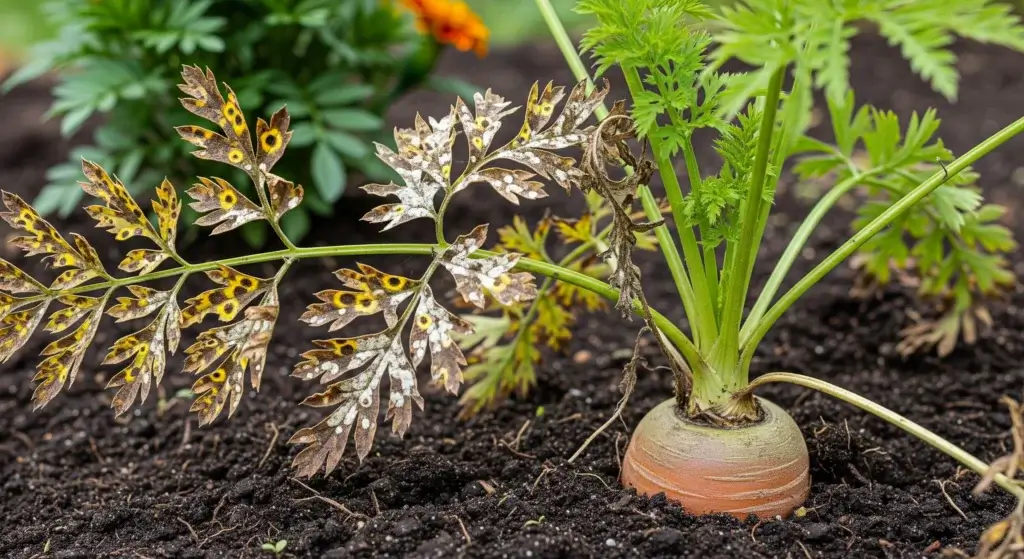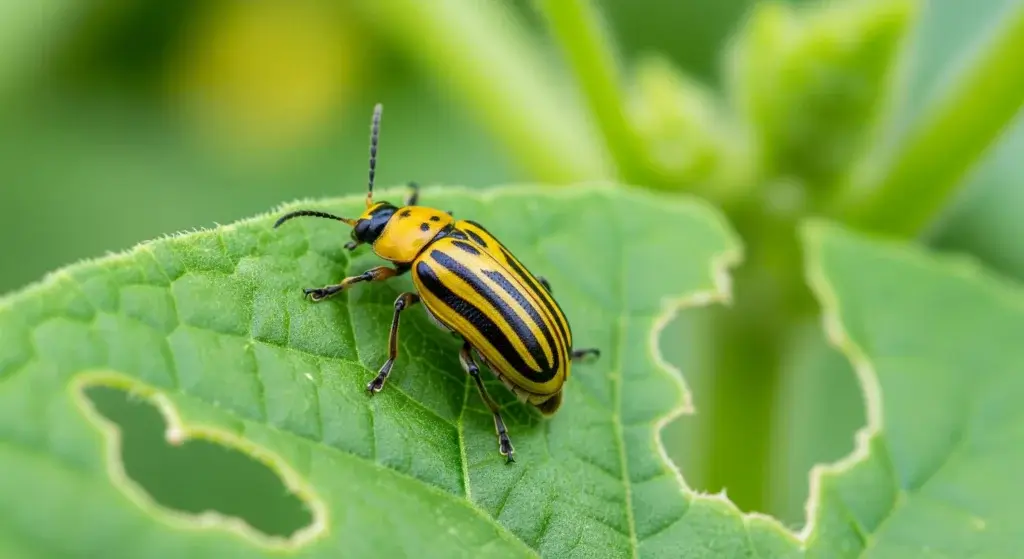
Tomatoes are a favorite crop in gardens and kitchens around the world.
Unfortunately, they are susceptible to various fungal diseases that can harm their health and reduce their yield.
By understanding these diseases, identifying their symptoms, and learning how to manage them, you can help your tomato plants thrive.
In this detailed guide, we’ll look at the common fungal diseases that affect tomatoes and discuss effective methods for controlling them.
Common Fungal Diseases that Infect Tomato Plant
Tomato plants are vulnerable to several fungal diseases, each presenting unique symptoms and challenges.
Here are some of the most common fungal diseases that can affect your tomato plants:
- Read also: Growing Healthy: A Guide to Natural Pesticides for Tomatoes
- Read also: Effective Strategies for Getting Rid of Tomato Hornworms
Early blight
Early blight, caused by the fungus Alternaria solani, is a common problem, particularly in wet and humid conditions.
This disease shows up in several ways:
- Look for dark rings on leaves, stems, and fruits. These rings look like targets.
- It can cause leaves to drop early, which reduces the plant’s ability to photosynthesize properly.
Early blight thrives in warm, wet environments, so it’s important to keep a close eye on your plants during rainy seasons.
Late blight
Late blight, caused by the fungus Phytophthora infestans, is infamous for triggering the Irish potato famine and is also a major threat to tomatoes.
Here’s what to watch for:
- Water-soaked spots on the leaves that quickly turn dark brown with a yellow halo. The fruits may get brown, firm spots that eventually rot.
- This disease can wipe out a tomato crop if not dealt with quickly.
Late blight thrives in cool, moist environments, so it’s important to take preventive steps during such conditions.
Septoria leaf spot
Septoria leaf spot, caused by the fungus Septoria lycopersici, is a common issue for tomatoes, especially in wet weather.
Here’s what you should look for:
- Small, circular spots with dark edges appear first on the lower leaves and gradually spread upwards.
- These spots can join together, creating large patches of dead leaf tissue. The affected leaves eventually fall off, weakening the plant.
This disease thrives in moist, humid conditions, so it’s essential to keep a close watch and manage it effectively.

Fusarium wilt
Fusarium wilt, caused by the fungus Fusarium oxysporum f. sp. Lycopersici, is a soil-borne disease that impacts tomato plants by entering through the roots.
Here’s what to look for:
- Yellowing of the leaves, often starting on one side of the plant. Eventually, the entire plant may wilt.
- The plant’s vascular system turns brown, restricting water and nutrient flow, which leads to stunted growth and death.
Fusarium wilt is more common in warm soil conditions and can stay in the soil for many years, making crop rotation essential.
Powdery mildew
Powdery mildew, caused by the fungus Leveillula taurica, affects many plants, including tomatoes.
Key signs to watch for include:
- White, powdery spots on leaves, stems, and flowers. These spots can merge and cover entire leaves.
- The disease leads to leaf distortion, reduced photosynthesis, and stunted plant growth.
Powdery mildew thrives in warm, dry conditions and can spread quickly in crowded, poorly ventilated gardens.
Anthracnose
Anthracnose, caused by the fungus Colletotrichum spp., commonly affects the fruits of tomato plants.
Here’s what to look for:
- Small, sunken, water-soaked spots on ripe or overripe fruits. These spots grow larger and darker, developing sunken centers with concentric rings.
- This disease can lead to significant fruit rot, reducing both yield and marketability.
Anthracnose thrives in warm, wet conditions and is often spread by splashing water.
Gray Mold
Gray mold, caused by the fungus Botrytis cinerea, affects a variety of plants, including tomatoes.
Key characteristics include:
- Grayish-brown mold growing on leaves, stems, and fruits. Infected areas become soft and mushy.
- The disease can cause significant damage to fruits, especially in humid conditions.
Gray mold thrives in cool, damp environments and is often a problem in greenhouses or poorly ventilated areas.
Buckeye rot
Buckeye rot is a serious fungal disease affecting tomatoes, caused by three pathogens: Phytophthora nicotianae var. parasitica, P. capsici, and P. drechsleri.
It primarily targets the fruit and can lead to significant losses if not managed properly. Here’s a closer look at buckeye rot:
- Look for brown, oily-looking lesions on the infected fruit. These lesions often start small but can quickly grow, covering large parts of the fruit.
- The lesions may have a distinctive zonate pattern, resembling the eye of a buckeye nut, which is how the disease got its name.
- As the disease progresses, the affected areas become sunken and develop a firm, leathery texture.
Buckeye rot thrives in warm, wet conditions, especially where water accumulates around the base of the plants.
The pathogens spread easily in waterlogged soils and during heavy rain or poor drainage. High humidity also promotes the growth and spread of the fungi.

How to Control Fungal Diseases on Tomato Plant
To manage fungal diseases in tomato plants, you need to focus on two key approaches: prevention and treatment.
Here are some effective strategies:
Prevention approaches
Cultural practices
- Proper watering: Water deeply at the base of the plant in the morning, allowing leaves to dry throughout the day. Avoid overhead watering which keeps leaves wet.
- Air circulation: Space plants adequately, prune lower leaves, and stake or cage plants to improve air flow around them. This drying effect discourages fungal growth.
- Crop rotation: Don’t plant tomatoes in the same spot where they or other nightshades (eggplant, pepper, potato) grew in previous years. Rotate with different vegetables to disrupt fungal life cycles in the soil.
- Mulching: Apply a layer of organic mulch around the base of the plant to suppress weeds, retain moisture, and prevent soil-borne fungal diseases like Verticillium wilt and Buckeye rot.
- Sanitation: Remove and dispose of infected plant debris to reduce the spread of fungi.
Planting resistant varieties
Choose tomato varieties known for resistance to specific fungal diseases common in your area.
Look for labels mentioning resistance to Early blight, Septoria leaf spot, etc.
Treatment approaches
Apply fungicides
If preventative measures fail and you see signs of fungal disease, fungicides can help control the spread.
Apply fungicides at the first sign of disease.
Products containing chlorothalonil, mancozeb, or copper-based fungicides can be effective against a range of fungal diseases.
However, for organic gardening, alternative solutions are preferred.
Using organic options
- Baking soda spray: Mix 1 tablespoon baking soda, 1 teaspoon vegetable oil, and a little mild soap per gallon of water. Spray on leaves but be aware of potential for leaf burn, especially in hot weather. Reapply regularly.
- Compost tea/extracts: There’s some evidence that compost teas or extracts can suppress fungal growth. Research homemade recipes or purchase them from garden centers.

- Read also: Tiny Terror, Big Problem: A Guide for Controlling Fungus Gnats
- Read also: Pest Damage on Vegetables: A Guide to Identification and Control
Conclusion
Fungal diseases can significantly impact the health and yield of tomato plants.
By recognizing the symptoms early and implementing effective control measures, you can protect your plants and enjoy a successful harvest.
Regular monitoring, proper cultural practices, and timely interventions are key to managing these diseases.
Remember, a healthy garden starts with healthy plants.
FAQs
The first signs often include discolored spots on the leaves, stems, or fruits. Leaves may yellow, wilt, or drop prematurely, and fruits can develop dark, sunken spots.
Infected plant debris should be removed and destroyed, not composted, as the pathogens can survive and infect future crops. Bagging and discarding the debris is an effective disposal method.
Crop rotation helps prevent soil-borne diseases like Fusarium wilt by disrupting the life cycle of pathogens that thrive on tomato plants. Rotate tomatoes with non-host crops such as corn, beans, or leafy greens.
Yes, it is generally safe to eat tomatoes from affected plants. However, any infected parts of the fruit should be removed and discarded.
Yes, many fungal diseases can spread to other solanaceous plants like potatoes, peppers, and eggplants. Practicing good garden hygiene and crop rotation can help prevent the spread.



